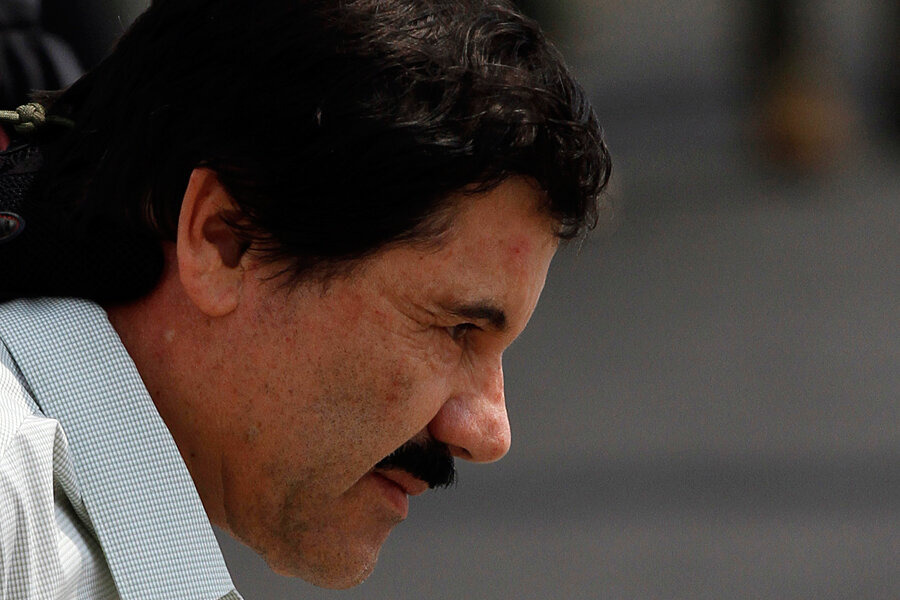Why 'El Chapo' capture could intensify Mexico's drug wars
Loading...
A roundup of news and analysis.
The capture of one of the Western Hemisphere’s most-wanted drug traffickers over the weekend ended a 13-year manhunt in Mexico and the United States. As US federal prosecutors now push to extradite Joaquín Guzmán, known as “El Chapo” or "Shorty," there is concern that his arrest could lead to a spike in violence across Mexico as rival drug cartels jostle for turf.
Whether Mr. Guzmán's arrest will lead to bloody, internecine cartel warfare in Mexico could depend on how the landscape of organized crime has changed, analysts say.
“There is a feeling of uncertainty, a worry of what could come next,” journalist Javier Valdez in Sinaloa state told Time over the weekend after Guzmán's arrest.
Guzmán is the face of the Sinaloa Cartel, named after the Pacific Coast state where the group originated. Under his leadership, their influence has grown far beyond Mexico, reaching deeper into Latin America, the US, and, by some accounts, Europe and Asia. Guzmán rose to international notoriety in 2001 after escaping from a high-security Mexican prison by allegedly bribing prison guards and getting smuggled out in a laundry basket. The US offered a nearly $5 million reward for his capture.
Often when a cartel leader is eliminated from the equation, infighting can quickly follow. At the same time, competing cartels may try to muscle into their territory, resulting in violence and bloodshed. According to Time:
…Mexican communities have seen the trail of blood left by gunmen who fought in the name of Guzman. The druglord’s Sinaloa Cartel battled along the entire 2,000-mile Mexican border for space to smuggle marijuana, heroin, cocaine and crystal meth to a U.S. drug market estimated by the United Nations to be worth about $60 billion a year, half of which is believed to go to Mexican gangsters. Squads of assassins used assault rifles and grenade launchers to protect Guzman’s empire. At one scene in Nuevo Laredo in 2012, 14 bodies were hung from meat hooks, along with a note signed, “Attentively, Chapo. Remember I am your real daddy.”
With the arrest of Guzman, there is concern that junior lieutenants could fight to take over the Sinaloa cartel empire. The cartel’s second most powerful figure Ismael “Mayo” Zambada is a veteran trafficker in his sixties, who is believed to have distanced himself from the cartel wars of recent years. “Zambada is trying to avoid arrest himself, so it will be hard for him to exert control,” Vigil said. Another fear is of rivals pushing into Chapo’s territory.
The Zetas, whose territorial bloodshed has reportedly left mass graves with hundreds of bodies, have long fought the Sinaloa Cartel. Another Sinaloan trafficker Hector Beltran Leyva has waged war with Guzman, leaving piles of severed heads and bullet ridden bodies in Sinaloa. “People are scared about more violence breaking out, of what reaction the cartels will have,” Valdez said.
But not everyone buys the idea that eliminating the head of a Mexican drug cartel automatically triggers widespread infighting. Steven Dudley, codirector of InSight Crime, which writes on organized crime in the Americas, said that a “change in the dynamics and makeup of the underworld [in Mexico] has been coming for a long time. What were once five major cartels in the late 1990s had morphed into 80 criminal groups operating in nearly every state by late 2012.”
To a certain extent, Guzman’s organization, the Sinaloa Cartel, had taken advantage of this atomization, spreading into new territory in recent years, most notably Tijuana and Juarez. Along the way, the Sinaloa Cartel could not avoid atomizing itself, thus leaving its structures greatly weakened and its leaders vulnerable….
With at least 80 criminal organizations operating throughout the country, the competition is fierce. Their objectives vary but increasingly the battleground is not the international but the national market.
Paradoxically, this is what the government wants. These are smaller organizations, with less ability, connections and capital to compromise the state. They therefore represent less of a national and more of a local threat.
They have less ability and fewer connections on an international level as well. In fact, it appears as if the days of the vertically integrated, monolithic trafficking organizations are coming to an end.
This doesn’t mean the next steps in Mexico’s fight against drug violence and trafficking will be easy, writes Mr. Dudley. He notes that the Sinaloa Cartel is still alive and kicking, with a "sophisticated structure" spread across a large swath of Mexico.
"But its power is waning. And it is difficult to imagine Guzman passing the torch to anyone from a younger generation, at least one that could successfully restore it to its former status," Dudley writes.
Guzmán was captured in the Pacific beach town of Mazatlan on Saturday morning in an operation run by the Mexican Marines, based on intelligence gathered by the US Drug Enforcement Administration. No shots were fired, and for many, this arrest signaled concrete progress in Mexico’s long fight against drug trafficking and violence. More than 70,000 people have died as a result of drug-related violence since 2006, when former President Felipe Calderón unleashed the military to fight traffickers head on.
The arrest was a huge boost for Mexican President Enrique Peña Nieto, now in his second year in office. “This is the most significant arrest of a drug trafficker in decades,” Mike Vigil, former head of international operations for the US Drug Enforcement Administration, told Time.
“Chapo Guzman was definitely the biggest trafficker in Latin America, and in my opinion in the world.”






